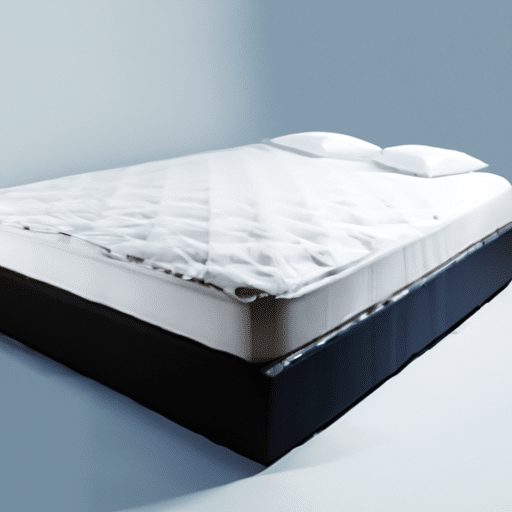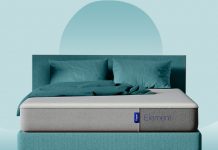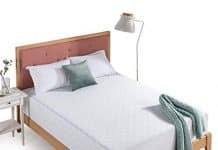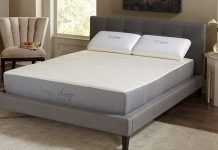Curious about whether or not it’s possible to use a mattress without a box spring? Well, let us put your concerns to rest and provide you with some insight. We understand the importance of a good night’s sleep, and sometimes figuring out the best setup for your bed can be quite the puzzle. In this article, we’ll explore the various options available to you when it comes to using a mattress without a box spring and discuss some factors to consider before making a decision. So, if you’re searching for answers and a friendly guide to help you along the way, you’ve come to the right place!
Review contents
Benefits of Using a Box Spring
Added height
One of the key advantages of using a box spring is the added height it provides to your bed. A box spring raises the mattress off the ground, making it more accessible and comfortable to get in and out of bed, especially for individuals who may have mobility issues. The elevated height can also contribute to a more visually appealing bed setup, giving the room a polished and put-together look.
Improved mattress support
Another benefit of using a box spring is the improved support it offers to your mattress. Box springs are designed to absorb shock and distribute weight evenly, preventing excessive wear and tear on your mattress. This can help extend the lifespan of your mattress and maintain its shape and integrity over time. The added support can also enhance your sleeping experience, providing a more stable and comfortable surface to rest on.
Enhanced mattress lifespan
By providing effective support and reducing stress on the mattress, using a box spring can help prolong the lifespan of your mattress. Without proper support, mattresses may sag and develop uneven wear, leading to discomfort and the need for replacement sooner than expected. A box spring acts as a sturdy foundation, preventing these issues and ensuring your mattress remains in good condition for a longer period of time.
Alternatives to a Box Spring
Platform bed frames
For those seeking a different option, platform bed frames offer an alternative to traditional box springs. These frames are typically made of solid wood or metal slats, providing a sturdy base for your mattress without the need for a box spring. Platform bed frames often have a low-profile design, resulting in a sleek and modern aesthetic. They offer excellent support and may feature additional storage space underneath, making them a practical choice for those with limited room.
Adjustable bed bases
Another popular alternative is an adjustable bed base, which allows you to customize the positioning of your mattress. These bases typically feature a motorized mechanism that allows you to elevate or lower different sections of the bed to your desired position. Adjustable bed bases often provide excellent support and can alleviate common sleep issues like snoring or acid reflux. While they can be more expensive than a traditional box spring, they offer added functionality and comfort.
Slatted bed frames
Slatted bed frames are another option that can provide support for your mattress without the need for a box spring. These frames feature a series of wooden or metal slats across the frame, creating a stable and breathable surface for your mattress. Slatted bed frames allow for increased airflow, which can help regulate the temperature of your mattress and prevent moisture buildup. They are often less expensive than box springs and can be a versatile choice for various mattress types.
Considerations Before Using a Mattress Without a Box Spring
Mattress type and compatibility
Before deciding to use a mattress without a box spring, it is essential to consider the type of mattress you have and its compatibility with alternative support systems. Some mattresses, such as memory foam or latex mattresses, may require specific types of support to ensure optimal performance and longevity. It is important to consult the manufacturer’s guidelines or contact their customer service to determine if alternative support systems are suitable for your specific mattress.
Desired mattress firmness
The choice of support system can also affect the overall firmness of the mattress. Box springs tend to provide a softer and more springy feel, while platform bed frames and slatted bed frames can result in a firmer surface. Adjustable bed bases offer the advantage of adjusting the firmness according to your preference. Consider your desired level of firmness and how it may be influenced by the support system when making a decision.
Weight distribution
Weight distribution is an important aspect to consider when using a mattress without a box spring. Box springs are designed to evenly distribute the weight of the mattress and sleepers, reducing pressure points and ensuring a comfortable sleeping surface. Alternative support systems should be chosen with this in mind, aiming to provide the same level of weight distribution and support to ensure a restful night’s sleep.
Pros of Using a Mattress Without a Box Spring
Cost-saving option
One of the major advantages of using a mattress without a box spring is the cost-saving benefit. Box springs can be an additional expense, especially when purchasing a new mattress. By opting for alternative support systems such as platform bed frames or slatted bed frames, you can eliminate the need for a box spring and save on the overall cost of your bed setup.
Versatility in bed design
Using a mattress without a box spring allows for greater versatility in bed design. With alternative support systems, you have the freedom to choose various bed frames or even create a customized setup that complements your personal style and preferences. This flexibility in design opens up a world of possibilities for creating a unique and visually appealing bedroom aesthetic.
Easier to move or transport
Another advantage of not using a box spring is the ease of moving or transporting the mattress. Traditional box springs can be bulky and difficult to maneuver through narrow hallways or staircases. When using alternative support systems, the mattress becomes more lightweight and easier to handle. This makes it convenient when moving to a new home or rearranging furniture within your existing space.
Cons of Using a Mattress Without a Box Spring
Less height and storage space
One drawback of using a mattress without a box spring is the reduction in overall height. If you prefer a higher bed setup, using alternative support systems may not provide the same level of elevation as a box spring would. Additionally, box springs often offer additional storage space underneath the bed, which can be beneficial for those with limited storage options in their living space.
Reduced airflow and breathability
Box springs are designed with slatted or ventilated surfaces, allowing for increased airflow and breathability for the mattress. When using alternative support systems like platform bed frames or slatted bed frames, there may be less airflow, which could result in moisture buildup and potential issues with mold or mildew. Proper mattress maintenance and regular cleaning can help mitigate this concern.
Potential voiding of mattress warranty
It is important to note that using a mattress without a box spring may void the warranty provided by the mattress manufacturer. Many mattress warranties require the use of a specific type of support system, such as a box spring, to ensure the mattress’s longevity. If you choose alternative support systems, be sure to review the warranty terms and conditions to understand any potential impact on the warranty coverage.
Steps to Use a Mattress Without a Box Spring
Ensure proper mattress support
When using a mattress without a box spring, it is crucial to ensure proper support for the mattress. This can be achieved by choosing an alternative support system that is compatible with your specific mattress type. Take into consideration the weight of the mattress and sleepers to ensure an adequate support system that prevents sagging and maintains the integrity of the mattress.
Consider using slats or a bunkie board
When using platform bed frames or slatted bed frames, it is important to consider the spacing and quality of the slats. Opt for sturdy and evenly spaced slats to provide optimal support for your mattress. Additionally, using a bunkie board, which is a thin and solid foundation that can be placed between the mattress and the support system, can further enhance the support and stability of the mattress.
Place the mattress on a solid surface
If alternative support systems are not feasible or compatible with your mattress, another option is to place the mattress directly on a solid surface. This can be a flat and sturdy platform or even the floor itself. Ensure that the surface is clean and free of any sharp objects that may damage the mattress. Additionally, consider using a non-slip mattress pad or rug underneath the mattress to prevent it from sliding.
Tips for Maintaining a Mattress Without a Box Spring
Regularly rotate the mattress
To ensure even wear and prolong the lifespan of your mattress, regularly rotate it 180 degrees. This helps distribute the weight and pressure placed on the mattress, preventing sagging in specific areas. Follow the manufacturer’s recommendations for rotation frequency, typically every three to six months, to maintain optimal support and comfort.
Use a mattress protector
Regardless of whether you use a box spring or an alternative support system, using a mattress protector is essential for maintaining cleanliness and protecting your investment. A mattress protector acts as a barrier against spills, stains, dust mites, and allergens, keeping your mattress fresh and hygienic. Choose a waterproof and breathable mattress protector that is easy to remove and wash.
Consider additional comfort layers
When using a mattress without a box spring, you may find that additional comfort layers enhance the sleeping experience. Mattress toppers, mattress pads, or even a thicker comforter can add an extra layer of cushioning and softness to your bed setup. Experiment with different combinations to find the level of comfort that suits your preferences.
Common Misconceptions about Using a Mattress Without a Box Spring
Lack of support and comfort
One common misconception is that using a mattress without a box spring may result in a lack of support and comfort. However, with proper alternative support systems, such as platform bed frames or slatted bed frames, you can achieve excellent support and comfort comparable to that of a box spring. It is important to choose high-quality support systems that provide adequate weight distribution and stability.
Incompatible with certain mattress types
Another misconception is that using a mattress without a box spring is incompatible with certain mattress types. While it is true that some mattresses, particularly those that require specific support systems, may not be suitable for alternatives to box springs, many mattress types can be used with various alternative support systems successfully. Always check the manufacturer’s guidelines and recommendations for your specific mattress type.
Necessity for a box spring
Many people believe that a box spring is a necessary component for a mattress, but this is not always the case. Box springs were traditionally used to provide additional support and height for older mattress designs. However, advancements in mattress technology, the availability of alternative support systems, and changing preferences have made box springs optional. The decision to use or not to use a box spring depends on personal preference and the specific requirements of your mattress.
Conclusion
In conclusion, the choice to use a box spring or not ultimately depends on your personal preferences and circumstances. While box springs offer benefits such as added height, improved mattress support, and enhanced mattress lifespan, there are also viable alternatives available. Platform bed frames, adjustable bed bases, and slatted bed frames offer their own advantages and can be suitable options for those seeking alternatives to traditional box springs. Before using a mattress without a box spring, consider factors such as mattress type compatibility, desired firmness, and weight distribution. Additionally, be aware of the pros and cons associated with using alternative support systems, including cost savings, versatility in bed design, and potential drawbacks such as reduced height and storage space. By following steps for proper mattress support and maintenance, you can enjoy a comfortable and supportive sleep experience without the need for a box spring.































